 |
|

|
 |
TABLE of CONTENTS
|
International partnership works to replace Hwy 72 bridge in Baudette |
By TJ Melcher, District 2 public engagement

The Baudette/Rainy River International bridge was built in 1960 and is being replaced with a new bridge that will open in 2020. Photo by David Gonzalez |
If you stand and look out over the banks of the Rainy River to the opposing shores with Canada, you’ll see what looks like any other bridge project, but it isn’t. Yes, there are construction cranes and a river barge with pile driving equipment. However, behind the scenes, the Hwy 72/King’s Hwy 11 bridge project in Baudette is anything but ordinary. It has an international flavor with its direct connection to Rainy River, Ontario.
The $39.3 million project to replace the Baudette/Rainy River International bridge is a partnership between MnDOT and the Ontario Ministry of Transportation. Even though the partners could split all of the costs, they couldn’t split all of the work. The design work was done collaboratively, but other processes needed be done separately.
“The environmental assessment can be a long process by itself,” said Joe McKinnon, project manager. “But both countries require their own version of environmental approvals, so it was like doing it twice.”
Another difference was historic considerations. The original steel bridge was completed in 1960 and is a rare example of a Pennsylvania through-truss, which made it eligible for listing in the National Register of Historic Places. Because of that eligibility, U.S. law requires that any state proposing demolition of a historic bridge must market its availability to any responsible government or other entity in order to preserve and relocate the bridge to a different location.
But Canada did not consider the bridge historic.
“Because of its historic designation we had to try and offer the bridge for sale,” said McKinnon. “But since ownership of the bridge is split with Canada, we were actually advertising only half of a bridge for sale.”
The advertising for the chance to buy half of a bridge created a stir online and in the media, but it didn’t generate any interested parties due to the considerable costs to disassemble, move and reassemble.
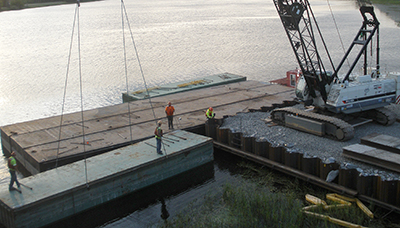
Construction for the replacement of the Baudette/Rainy River International Bridge between Baudette, Minn. and Rainy River, Ontario is underway. The current bridge will remain in place until the new bridge is complete in 2020. Photo by JT Anderson |
All told, the additional requirements for international coordination added an extra year or two to the project schedule. Along with the Canadian permit requirements, project staff also had to coordinate with the DNR, Army Corps of Engineers, U.S. Coast Guard, International Joint Commission and the International Boundary Commission.
Motorists will continue to use the existing bridge while the new one is constructed just east of the current structure. The new international bridge will be constructed with a five-span, continuous steel “I-girder” design.
It is expected to be open for traffic in 2020, and then the old bridge will be torn down. |
 |
|

|
 |
TABLE of CONTENTS
 |
Bemidji, Crookston sign crews reach 3,000-day safety milestone |
By Sue Roe
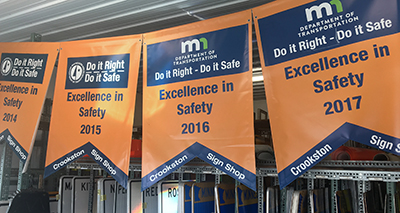
Banners hang in the Crookston sign shop acknowledging the crews’ years of having no lost-time injuries. Photo by TJ Melcher |
Earlier this month, the District 2 Bemidji and Crookston sign crews celebrated a milestone. Eight years in the making, the crews reached the 3,000-day mark Sept. 6 for days without a lost-time injury.
OSHA defines a lost-time injury as one where an employee is not able to return to work or assigned restricted work after a workplace incident.
“It was mostly another day for them, but it’s a huge accomplishment,” said Brady Thorson, sign supervisor for both crews. “They’re proud of it and are inspired to keep going. It was nice to all get together, recognize the day and talk about this great achievement.”
Sign crews install, repair and replace signs on all types of highways. Signs are erected when there are construction and maintenance projects that cause detours, closures and lane reductions. Weather-related incidents also necessitate the need for signs. In the winter, their job is especially challenging with slippery roads and ditches.
Thorson credits employees with implementing the recently introduced Red Book into their daily operations to help them focus on what safety hazards they might be facing. Pre-task planning assists employees to identify and discuss hazards that can hurt them. By recognizing hazards in advance, employees are less likely to get injured.
“We talk about those hazards so they are always thinking what they might be facing out there,” he said. “I think the crew takes it one day at a time and they focus on what we are doing today and meeting each challenge. They take safety seriously and they’ve developed a strong safety habit. I admire them because they have tough jobs.”
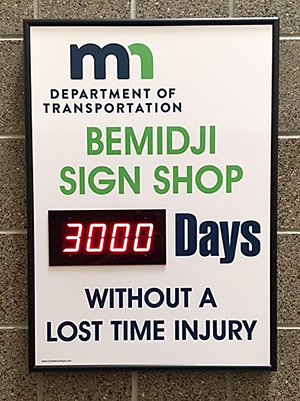
Safety countdown clocks mark 3,000 days without a lost-time injury for the Bemidji sign crew. Photo by TJ Melcher |
Rod Starkey, statewide safety culture program coordinator, said there are seven people currently in the two crews, but the eight-year record encompasses more employees.
“There have been numerous employees working in the sign shop during this eight-year time period,” he said. “As the supervisor, Brady sets the tone regarding safety. His leadership makes the difference. These crews prove that high safety performance and high production go hand in hand.”
Thorson said each employee knows they can stop what they are doing and re-evaluate the situation if they deem it unsafe.
“They step back and they have the freedom to make changes,” he said. “If a co-worker isn’t doing something that’s safe, we support each other. I believe in the buddy system.”
Monthly safety meetings also help the crews prioritize safety in their jobs.
“We can’t emphasize enough about safety,” he said. “We’ve developed a work environment that’s comfortable with not a lot of stress, as that can contribute to unsafe practices.”
He said the crews’ safety accomplishment not only is because of their commitment to a safe workplace, but because there is strong safety support in the district.
“Our leadership is very supportive,” he said. “When we told them that crews were facing challenges in the winter because of slippery ditches, we got cleats to wear on our shoes. The district helps us do our jobs safely.”
He said he’s gotten comments from the public and others when they see employees wear their personal protection equipment on the job.
“Things like their vests, hard hats, hearing protection, glasses and gloves – that becomes like putting on their shoes,” Thorson said. “We want everyone to go home every day with all their toes and feet.”
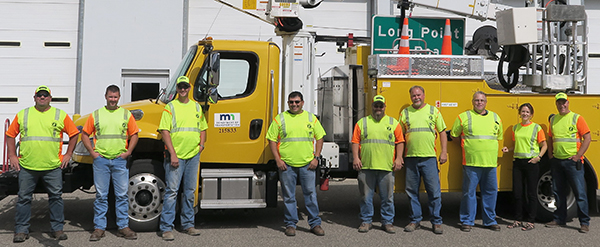
Members of the Crookston and Bemidji sign shops include from left, Mark Ronning, Todd J. Larson, Justin Erdmann, Pablo Gonzales, Brock Kuchan, Chris Boerger, Brady Thorson, sign supervisor, Michelle Rognerud, D2 traffic engineer, and Rod Starkey, statewide safety culture program coordinator. Photo by TJ Melcher |
|
 |
|

|
 |
TABLE of CONTENTS
 |
Urban youth internship program completes second year in Metro District |
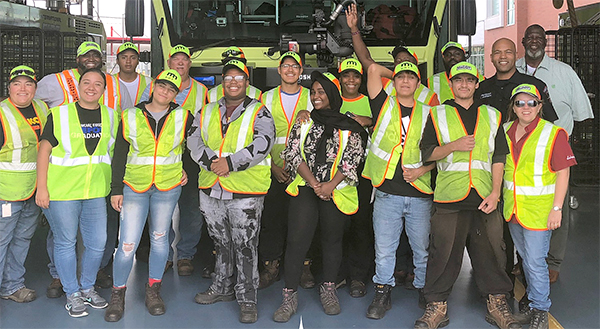
The urban youth internship program completed its second year this summer under the direction of DeWayne Jones, Metro District maintenance superintendent. The program is designed for 16-18 year olds to help the Metro District with mowing, litter pickup and brush removal behind noise walls and right of way fences.
The group toured the Minneapolis-St. Paul International Airport maintenance facilities July 20. (Front row from left) Wendy Grant, Golden Valley traffic services; Brenda Sanchez, Governor’s office; Mikhaela Brown, UYC intern; Keshon Grant, UYC intern; Sahruja Abdi, UYC intern; Bryan Montano, UYC intern; Brian Earth, UYC intern; and Cassandra Isackson, Aeronautics director (back row from left) Carey Johnson, Maple Grove truck station; Loren Freitag, Golden Valley truck station; Rickiesah Grant, Maple Grove truck station; Sam White, Cedar truck station; Jamie Johnson, Camden truck station; a Minneapolis fireman; and DeWayne Jones, Metro District maintenance superintendent.
Photo courtesy of the Metro District |
|
 |
|

|
 |
TABLE of CONTENTS
 |
Training program prepares snowplow operators for winter |
By Sue Roe
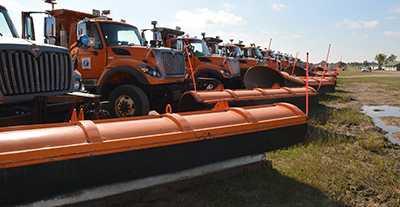
Snowplows are lined up at Camp Ripley in preparation for SPOT training, which began Sept. 17 for more than 100 snowplow operators. Photo by Kristi Loobeek |
More than 100 snowplow operators from the MnDOT, the cities of Minneapolis and Rochester, and Scott County are training during the next two weeks at Camp Ripley near Little Falls, to learn how to safely and effectively plow snow.
MnDOT will conduct a second session Oct. 15-19 and Oct. 22-26, where an additional 60 MnDOT snowplow operators will be trained.
MnDOT’s snowplow operator training program, known as SPOT, is a two-week session that highlights a variety of safety measures, plowing techniques and best practices. The session provides trainees with updates on new equipment, policies and procedures related to winter highway maintenance operations.
“We have more than 1,500 snowplow operators clearing 30,000 lane miles of state highway each winter to ensure that motorists can get to where they want to go,” said Commissioner Charlie Zelle. “Getting people safely to their destinations is a team effort and our employees who plow snow are on the front line.”
As part of SPOT, MnDOT maintenance supervisors and other staff provide classroom and hands-on training and share their experience and insights with the trainees.
“Our snowplow operator training program offers unique and specialized training that makes our snowfighters ready for any kind of Minnesota winter,” said Steve Lund, state maintenance engineer.
Snowplow operators will receive training this year on MnDOT’s Maintenance Decision Support System and Automated Vehicle Location technology. The technology provides operators with weather and road information to make decisions on what type of treatment (sand or salt) and in what quantity to use on the road. The AVL technology is installed on about 76 percent of the agency’s 840 plow trucks.
Last week, 45 MnDOT employees attended a Train the Trainer session to learn how to provide the training to snowplow operators.
MnDOT has trained more than 1,900 snowplow operators since the training began in 2004. |
 |
|

|
 |
TABLE of CONTENTS
 |
Mark Gieseke named assistant division director for Engineering Services |
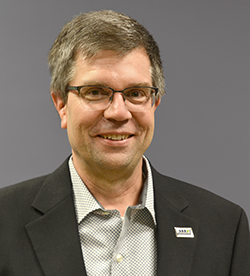
Mark Gieseke is the new Engineering Services Division assistant division director. Photo by Rich Kemp |
Mark Gieseke started his new role as Engineering Services assistant division director Sept. 5.
Gieseke has worked for the State of Minnesota for more than 35 years, starting out as a rotating Graduate Engineer in his earliest years, and then working in a variety of positions over the years including preliminary design, final design, soils and various roles in State Aid. He served as the State Materials testing engineer, the Metro District State Aid manager, Office Director for Electronic Communications and most recently as the Office Director for Transportation System Management.
Gieseke has provided oversight to highway investment planning and programming, including the Corridors of Commerce program, led the project selection audit of MnDOT and the development of project selection criteria. He also led the update to MnDOT’s cost participation policy and guidance.
“Mark will be charged with championing efforts focused on the cornerstones of project management, advancements in technology including CADD/DMS/3D & 4D Modeling and Design, and alternative project delivery methods,” said Nancy Daubenberger, assistant commissioner, Engineering Services. “He will also continue his leadership role in the Corridors of Commerce program as the Program Manager.”
Gieseke has a bachelor of science degree in civil engineering from South Dakota State University and a master's of business administration from the University of Phoenix.
“I’m excited to have Mark take on this role with his collaborative leadership style, his comprehensive MnDOT experience and his approach to bringing groups throughout MnDOT together as we work toward the the goals of MnDOT’s Strategic Operating Plan,” said Daubenberger.
Gieseke’s office is on the fourth floor of CO. He can be reached at 651-366-4808. |
 |
|

|
 |
TABLE of CONTENTS
 |
Employees urged to try multimodal transportation on World Car-Free Day Sept. 21 |
By Sue Roe

Employees are encouraged to take a bus, bicycle, carpool, car-share, light rail or to walk to work on Sept. 21 for World Car-Free Day. |
MnDOT employees are invited to participate in the third annual World Car Free Day Friday, Sept. 21, by commuting to work using an alternative mode instead of driving alone.
“This is a great opportunity to try a bus, bicycle, carpool, car-share, light rail or to walk,” said Lisa Austin, ABC Ramps coordinator.
The MnDOT-owned ABC Ramps along with the city of Minneapolis and Move Minneapolis are promoting the movement in the Twin Cities. Move Minneapolis is the downtown Transportation Management Organization that works for and promotes a sustainable transit and transportation system.
“We have a great multimodal network in Minnesota and experiencing a different mode of travel can help us all better understand the benefits of our transportation system,” said Austin.
Using alternative modes of transportation helps reduce vehicle and fuel costs, shorten commute times, lower carbon footprint and relieve the stress of driving alone.
More than 1,500 cities around the world celebrate World Car-Free Day. Last year, 1,800 Minneapolis downtown commuters pledged to go car-free by using sustainable transportation and many MnDOT employees biked, walked, carpooled or took the bus to work.
MnDOT’s Office of Transit and Active Transportation helps provide alternatives to driving alone and allows people to reduce their energy consumption and have equal opportunity to live independently. MnDOT administers state and federal transit assistance programs to support 70 public transit systems in the state. Read more about MnDOT’s role in transit. |
 |
|

|
 |
TABLE of CONTENTS
 |
Protect yourself, others - get vaccinated at work |
By Mary McFarland Brooks
Flu vaccines can protect you, your family and your co-workers from the seasonal flu. The vaccinations will be available at no cost with your Minnesota Advantage Health Plan member ID card at the locations listed on the State Employee Group Insurance Program website. All state employee health insurance cards, regardless of the plan, are advantage cards.
No appointment is necessary at the workplace clinics. Flu vaccinations are offered around Minnesota and locations can be found on the flu vaccination clinics website.
Employees without a valid card or who don’t have health insurance through the state of Minnesota can receive the flu shot for $33 (cash only).
The flu is a respiratory disease caused by a virus that attacks the nose, throat and lungs. The flu causes body aches, fever and extreme tiredness. It can vary from mild to severe and at times can lead to death. It is not the same as the “stomach flu.”
The flu shot is the quadrivalent vaccine that provides protection against four flu viruses. The Center for Disease control is not recommending use of the nasal spray vaccine this flu season.
Most people who get a flu shot have no side effects. A mild fever or some discomfort for a short time after being vaccinated can affect some people, but this is a sign that your body is responding to the vaccine. It is not the flu. Also, because there are many viruses circulating in the fall, it is possible to get sick with a different virus around the same time that the flu vaccine is received.
Print and fill out the consent form ahead of time for a shorter wait time. Consent forms will also be available the day of the flu shots.
This event is sponsored by your MnDOT Health and Wellness Committee. |
 |
|

|
 |
TABLE of CONTENTS
 |
Combined Charities Campaign launches Oct. 1 |
By Mary McFarland Brooks

|
The annual Minnesota State Combined Charities Campaign runs through October with a 2018 goal of 5 percent of MnDOT employee participation. Last year, 80 MnDOT employees (1.6 percent) pledged their support for charitable federations. To reach this year’s goal, 250 MnDOT employees will need to participate in the online giving campaign.
Also, this year MnDOT and the Department of Public Safety will host an Agency Challenge. Kristen Oster, the Combined Charities Coordinator for DPS, issued the Agency Challenge and MnDOT accepted. When the campaign closes in November 2018, the agency with the highest percentage of employee donations wins the “for fun contest.”
Employees may pledge to nonprofit organizations that work in areas such as hunger, access to healthcare, poverty, higher education, the arts and many more. Note: some federations will allow employees to designate to a specific non-profit 501(c)3 of their choice.
Mark your calendars for the Combined Charities Campaign vendor fair, Oct. 4, on the Ground Floor of the Transportation Building. There will be games and prizes in conference rooms G13 and G14 from 11 a.m. – 1:30 p.m. and an opportunity for employees to discuss charitable giving options with representatives from:
- Open Your Heart to the Hungry and Homeless
- PeaceMaker MN
- Community Shares of MN
- Local Independent Charities of MN
- Women’s Foundation of Minnesota (11 a.m. to noon)
- United Negro College Fund
- Greater Twin Cities United Way
- Minnesota Environmental Fund
Employees can participate by pledging online through the convenience of payroll deduction. Signing up for payroll deduction is a convenient way of giving to multiple organizations at once, and reduces administrative costs for the charities. Payroll Deduction also gives you an easy place to locate all of your charitable contributions for tax reporting purposes.
Contact the district Combined Charities Campaign coordinator if you have any questions:
District 1 – Karen Bohjanen
District 2 – Joe McKinnon
District 3 – JP Gillach
District 4 – Kayla Pavlacky
District 6 – Anne Meyer
District 7 – Anne Wolff
District 8 – Linda Vandendriessche
Metro – Maureen Widmer
Central Office – Karin Van Dyck & James Pontius
A pledge of $1 or $3 per pay period can make a difference in your community and provide another example of how “We Care. We Give. We are Minnesota.”
Pledging occurs online at the state of Minnesota’s self-service website. Payroll deductions begin with your first paycheck in 2019.
For more information visit: https://mn.gov/mmb/combined-charities/. |
 |
|

|
 |
TABLE of CONTENTS
 |
MnDOT receives Government Green Fleet Award |
By Sue Roe
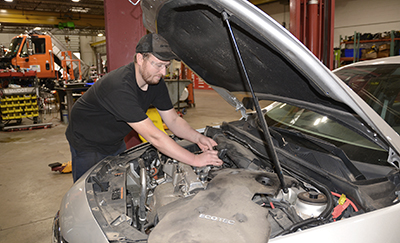
Tyler Sroka, heavy equipment mechanic, works on a MnDOT fleet vehicle at Central Shop. Sroka is one of 12 mechanics who maintain the agency’s fleet. Photo by Sue Roe |
MnDOT recently received a 2018 Government Green Fleet Award from the 100 Best Fleets in the Americas for its excellence in effective and efficient fleet operations. MnDOT was the only state department of transportation recognized this year.
The award was based on criteria that includes fleet composition, fuel and emissions, policy and planning, and fleet use. The criteria are the factors that help improve air quality, reduce emissions and increase fuel efficiency and usage.
MnDOT holds a Sustainable Fleet Accreditation from the NAFA Fleet Management Association, which submitted the nomination form on behalf of MnDOT.
“MnDOT continues to look for ways to lower operational costs while reducing greenhouse gas emissions,” said Tim Sexton, chief sustainability officer. “This award clearly reflects how MnDOT’s office of maintenance and the fleet management staff have become national leaders in this area.”
The agency’s fleet consists of vehicles and fuels to perform maintenance, snow plowing and other employee duties across the state. MnDOT currently owns more than 4,000 on-road vehicles, including 38 hybrid vehicles and four electric vehicles.
“Our fleet is moving in the direction of hybrid and electric vehicles. Our goal is to reduce fossil fuel consumption and one of the tools to help us get there is through hybrid and electric vehicles,” said Bob Ellingsworth, maintenance fleet manager.
Other strategies MnDOT uses to achieve fleet sustainability include:
- Eliminate unnecessary idling
- Optimize vehicle lifecycle standards
- Use the “right size” concept to use the right vehicle for the job to improve fuel efficiency
- Expand use of alternative fuels
|
 |
|

|
 |
TABLE of CONTENTS
 |
Camp MnDOT gives children a look at transportation |
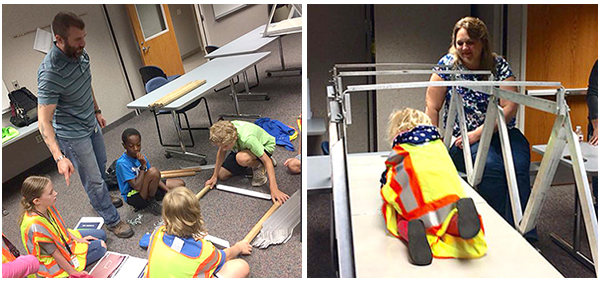
(Above left) Brandon Day, senior engineer, helps kids put the bridge-in-a-bag kit together. (Above right) Jessica Duncan, bridge evaluation engineer, assists kids crawling through a bridge to make sure they arrived safely. More than 60 children and grandchildren of Oakdale employees attended Camp MnDOT Aug. 28. The event included a State Patrol K9, State Patrol rollover simulator, drones, and many different pieces of equipment to explore.
“Camp MnDOT was a really great event for kids of all ages. From the State Patrol demonstration to seeing all the big equipment used by the maintenance staff, they were exposed to real-life situations while in a safe learning environment,” said Nate Blanchard, senior engineer. “Everyone involved did an amazing job, especially having to change things on the fly due to the weather. The kids really appreciated it, and I felt they came away with a better appreciation for what goes into MnDOT and the State Patrol.” Photo courtesy of the Bridge Office |
|
 |
|

|
 |
TABLE of CONTENTS
 |
Agency makes impressive gains with WIG 2.0 efforts |
By Commissioner Charlie Zelle
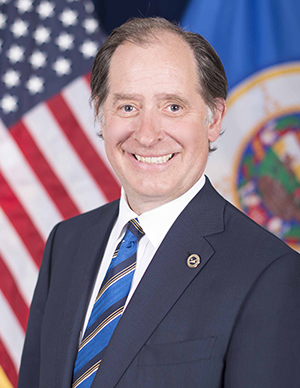
Charlie Zelle is the Commissioner of Transportation Photo by Rich Kemp |
Two years ago MnDOT employees across the agency began a journey to improve the way we do business, with a focus on Earning Customer Trust by Advancing Equity and Improving Intentional Customer Engagement through WIG 2.0. We challenged ourselves to find creative ways to use the tools we have, to communicate with each other better, to measure how we’re doing and to figure out how to keep improving.
WIG 1.0, Enhancing Financial Effectiveness, 2013 – 2015, laid the groundwork that helped MnDOT focus on becoming more financially effective in day-to-day operations and investing in areas with long-term benefits. As a result, the agency has made many improvements, set and reached new goals, gathered data that was previously unavailable and achieved greater credibility in agency decision-making. WIG 1.0 produced a deeper understanding and clarity about what is possible and developed concrete ways to make progress on those critical goals.
The many team successes produced through WIG 1.0 naturally led to greater customer trust—and to WIG 2.0: Earning Customer Trust. During WIG 2.0, employees worked to increase transparency through a customer-centered organization. WIG 2.0 sub-WIGs focused on engaging customers, listening to understand and balancing the diverse needs of MnDOT customers across the state to achieve the best possible outcomes.
Through these efforts, nearly 1,000 separate sub-WIGs were selected by teams across the state. I believe this shows the commitment, initiative and dedication of MnDOT employees to improve the work we do and how we interact with our customers, both internally and externally. Team sub-WIGs allowed us to close gaps in the diversity of our workforce and the businesses we contract with. Since WIG 2.0 began, MnDOT has awarded more than 200 small contracts, valued at approximately $11 million, with 65 percent of these awarded to eligible targeted small businesses. We’ve also increased opportunities for veteran-owned, disadvantaged business enterprises and targeted group businesses to contract with MnDOT.
The gains we’ve made through WIG 2.0 have been impressive. We’ve learned to challenge ourselves to shift from a producer to a customer-centered mindset to better understand our customers’ needs.
My sincere thanks to all of you for your hard work and dedication to making MnDOT a better place to work through the WIG 2.0 achievements. I also want to thank the nearly 100 employees who served as coaches and champions and led the WIG 2.0 efforts and the eight teams who went above and beyond in their C3 efforts. We could not have achieved the level of success we experienced without your innovative ideas and implementation.
I challenge each of you to continue to look for quality improvements and for better ways to meet our customers’ diverse needs across the state. Let’s take what we’ve accomplished in WIG 2.0 and make it the way we do our day-to-day work.
I applaud each of you and your efforts with WIG 2.0.
Please take a few minutes to enjoy this Thank You presentation. You can also find it on MnDOT’s iHUB main page for WIG 2.0. |
 |
|
| |
|



